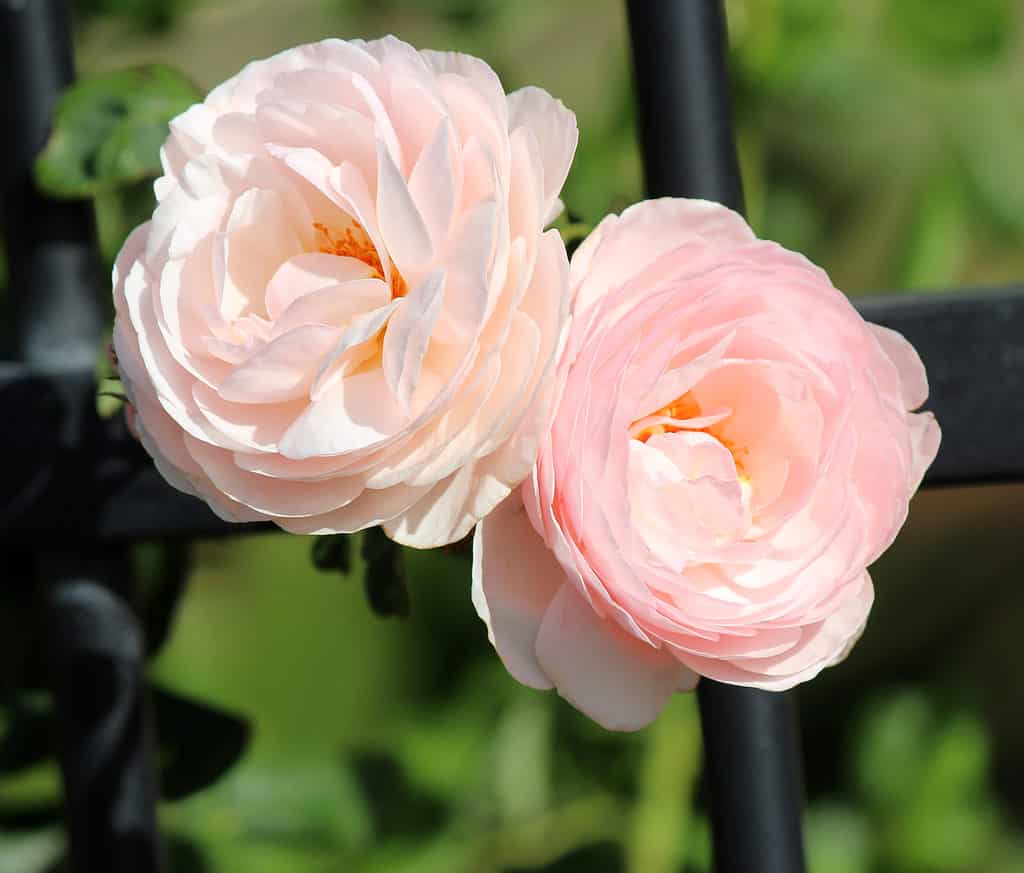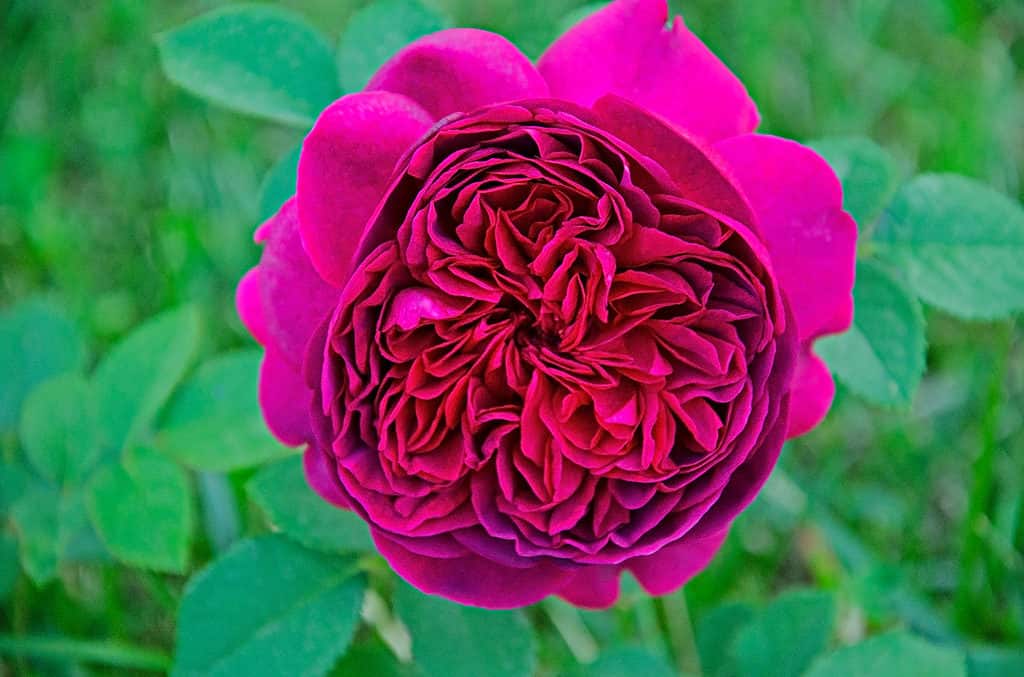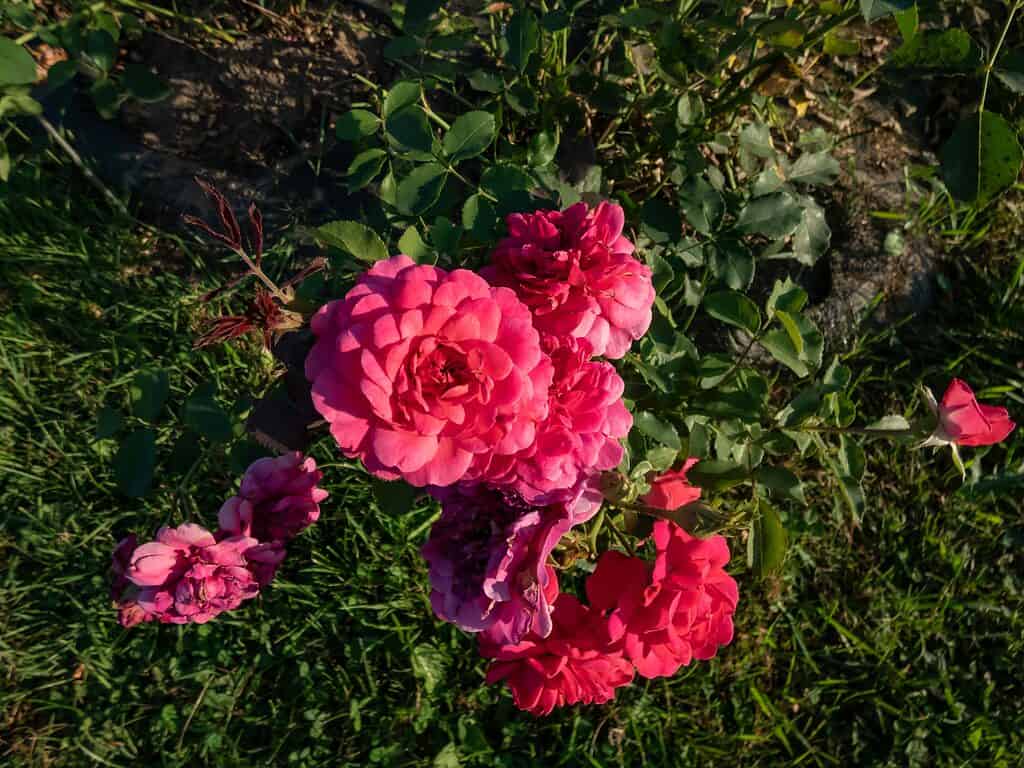Some of the most fragrant flowers you can find are English roses. Their double flowers, which blend their pleasant aroma with vibrant colors, are a mix between old roses and modern roses.
English roses have a better habit of blooming than many older varieties and can generally thrive in USDA hardiness zones five through nine. They blend well among perennials and frequently emerge as the garden’s centerpiece. English roses come in various hues, from the classic gentle pinks and creamy whites to striking corals, oranges, and yellows. These roses have some of the most significant petal counts you’ll encounter in any rose category. Many English roses also bloom repeatedly for years. To put it simply, if you want a classic look to your garden and a dependable, easy-to-maintain rose, the English rose is the way to go!
In this article, we’ll take a look at some of the most popular varieties of English roses, so you can make the right choice for your garden, landscaping project, or floral arrangement.
What is an English Rose?
David Austin, the famed British rose breeder, developed the category of English roses in the late 20th century. He made an effort to produce roses with the greatest qualities of both old and contemporary roses, including scent, hardiness, disease tolerance, etc. Another objective was to develop roses that produced flowers that resembled many of the classic rose varieties, such as cupped and rosette-shaped blossoms, which typically had several petals.
Crossing old roses, especially those from the 18th and 19th centuries, with modern roses from the 20th century proved successful in achieving this. David Austin combined the floribundas, hybrid teas, and modern climbers with the Gallicas, Damasks, Portlands, and Bourbons.
How to Grow English Roses
Plant your English rose somewhere its fragrance can be appreciated, such as next to dining room windows and along sidewalks. To flourish, they require a lot of sunshine.
English roses should be planted either after the final spring frost or six weeks before the first fall frost. By planting in the fall, the roots will have ample time to take root before hibernating for the winter. The whole root system should fit in the hole you create, so make sure to dip deep enough. To allow for growth, plants should be spaced at least three feet apart from each other.
English roses are not only prolific bloomers but also require relatively minimal maintenance. Having said that, there are a few things to take into account when growing English roses, including light, soil, water, etc.
For English roses to flourish, the soil must be well-drained. Some varieties rebloom and grow quickly, so it’s important to amend the soil with rich, well-aged compost and add fertilizer in accordance with the instructions on the container.
English roses thrive in direct sunlight. This produces the biggest and most flowers, and any foliar illnesses are also avoided. On the other hand, English roses thrive in partial shade, especially in warmer climes where protected afternoon light keeps them cool during the heat of the day and also aids in producing the most potent aroma.
If the earth includes clay products or is compacted firmly, loosen it up around a foot into the hole to aid drainage. English rose soil may also require manure or organic compost. To prevent the leaves and buds from becoming wet, which can lead to fungus infections, water roses at the base of the plant.
Roses may require less water when it’s really humid because of the moist air. Only if they’re drooping should you provide more water. Pests that harm your flowers might also come with high temperatures. You might need to cover your roses over the winter if you reside in a colder climate.
You probably won’t need to feed your plants fertilizer if your garden has rich soil or if you frequently amend it with compost or other types of organic materials. Use an all-purpose fertilizer if you’re growing roses in pots, but watch out for overfeeding, which might harm your plants.
With these growth tips in mind, let’s take a look at some beautiful English rose varieties!
Heritage Rose
Botanical Name: Rosa ‘Heritage’
This English rose is certainly unique in appearance, hue, and scent. It has an ambrosial scent that is stronger than many types of English roses. A single sniff will take you back to the garden where you first encountered the Heritage rose, as its unique scent really lingers. This bushy shrub would look nice as a focal point in a mixed border or in a bouquet. It can thrive in full sunshine in USDA hardiness zones five through 11. At maturity, this cultivar should grow to a height of five feet.

The Heritage rose (pictured) has a delightful pastel pink hue that doesn’t fade or get very vibrant.
©alybaba/Shutterstock.com
Happy Child Rose
Botanical Name: Rosa ‘Happy Child’
Rich golden flowers from the Happy Child rose are what make this variety so popular. That, and they resist fading in direct sunshine and rarely ever lose their color with proper care. Like other English roses, this variety thrives best in loamy, well-draining, and rich soil. Additionally, it needs daily exposure to six to eight hours of sunshine and regular fertilization. This variety of English rose has very huge blooms that are four to five inches wide. The plant itself often grows to a height of four feet. USDA hardiness zones five through 11 are ideal for cultivating this rose.
Fair Bianca Rose
Botanical Name: Rosa ‘Fair Bianca’
The Fair Bianca rose resides in that ideal aesthetically-pleasing region between white and cream, giving it a radiant look. This variety is prized by brides who wish to add a classic flare to their wedding flower bouquets since it reliably reblooms. In USDA hardiness zones five through 10, this nursery hybrid rose thrives. It grows most well in full sunshine and may quickly reach a height of four feet.
William Shakespeare Rose
Botanical Name: Rosa ‘Ausroyal’
Finally, a red rose with a genuine antique rose scent that you give to your classy special someone! This rose cultivar is younger and was introduced in the year 2000. It was widely planted at Shakespeare’s birthplace in Stratford-Upon-Avon, England. This rose goes by the marketing name “William Shakespeare rose,” although its cultivar name is Rosa ‘Ausroyal’. It is a hybrid of the Mary and Squire roses. This hybrid rose may grow to a surprising height of six feet and thrives in USDA hardiness zones five through nine. This cultivar needs full light to grow, much like the majority of English roses do.

The William Shakespeare rose (pictured) is a newer English rose cultivar that adds a touch of vibrancy to gardens and bouquets.
©Nerus Natalia/Shutterstock.com
The Mayflower Rose
Botanical Name: Rosa ‘The Mayflower’
The Mayflower rose is virtually disease-proof, making it stand out among other pink rose varieties. You can throw away your harmful chemicals and sprays when raising this plant. The Mayflower rose won’t need chemical fertilizers and pesticides to thrive. You won’t need much of anything, really. The Mayflower rose can grow very well with minimal human intervention.
This hardy, resilient shrub works well as a modest hedge or ground cover. It can live in USDA hardiness zones four through 11 since it is very hardy for an English rose. It may grow to a height of four and a half feet. English roses of this kind should only be planted in full sun.
Lady Emma Hamilton Rose
Botanical Name: Rosa ‘Lady Emma Hamilton’
The Lady Emma Hamilton rose is perfect for a big patio container because of its extremely compact growth habit. This English rose variety is particularly popular for its slightly strong fruity scent that lingers in the air. This cultivar is also well suited to growing as a rose tree because of its upright growth habit, even though it technically is not a climbing rose. In USDA hardiness zones five through nine, this hybrid rose thrives. At maturity, it may grow to a height of four feet and requires full sunlight to thrive.
Winchester Cathedral
Botanical Name: Rosa ‘Winchester Cathedral’
Early in the growing season, the Winchester Cathedral rose produces hundreds of white roses in profusion, followed by sporadic flushes during the rest of the growing season, and finally, an exuberant autumn finale of blooms. If you want a constantly-blooming English rose, this is the one to pick. When used as a blooming accent in a formal garden, the compact shape of this rose is quite attractive. USDA hardiness zones five through 11 will support the growth of this lovely white English rose. It will mature to a height of four feet, as do many English roses, and flourishes in direct sunshine.
Sir John Betjeman
Botanical Name: Rosa ‘Sir John Betjeman’
Sir John Betjeman rose, which bears the name of the well-known journalist and poet laureate, has vivid magenta flowers that stand out in the summertime environment. As an Alba and English rose hybrid, this rose possesses the qualities of superior scent and disease resistance that have made them a garden staple for many years. USDA hardiness zones five through 10 are ideal for growing this hybrid English rose. It will grow to a height of around five feet and thrive in direct sunshine.

The Sir John Betjeman rose (pictured) has unique petal shapes with a subtle soft touch, similar to carnations.
©Kristine Rad/Shutterstock.com
Janet Rose
Botanical Name: Rosa ‘Janet’
The popular Peace hybrid tea rose shares the same pink sunrise tones as the Janet rose, but this variety has more petals. The Janet rose thrives in areas with low humidity since it might be vulnerable to black spots and powdery mildew growth. We advise growing this hybrid English rose if you reside in one of USDA hardiness zones five through eleven. It grows to a height of around four feet and thrives in direct sunlight.
Munstead Wood
Botanical Name: Rosa ‘Munstead Wood’
The Munstead Wood English rose is the shrub that may transform a garden’s atmosphere. This rose’s neat growth habit is ideal for the container garden or the edge of the border, and the rich berry-toned blossoms smell as good as they look. British garden designer Gertrude Jekyll’s residence inspired this cultivar’s name. Although it only grows to a modest height of three feet and only blooms in full sunlight, this hybrid rose fares well in USDA hardiness zones five through 10.
With so many rich and beautiful English rose varieties, you’ll definitely be able to find the perfect English rose for your needs. We also recommend planting multiple English rose varieties together, as these flowers are absolutely stunning when planted in hedges of varying beautiful hues. If you have the patience to care for them, these are simply the best roses to have.
The photo featured at the top of this post is © MaCross-Photography/Shutterstock.com
Sources
- NCSU Staff, Available here: https://plants.ces.ncsu.edu/plants/rosa/
- Sheryl Geerts, Available here: https://www.bhg.com/gardening/flowers/roses/ultimate-rose-care-guide/
- Jamie McIntosh, Available here: https://www.thespruce.com/english-rose-varieties-4136936
FAQs (Frequently Asked Questions)
What are English roses?
English roses might have an old-fashioned appearance, but they are actually hybrids that are made by crossing old roses with modern shrub roses.
Are English roses difficult to grow?
English roses are not too difficult to grow. They just require a little bit of TLC and maintenence.
What type of sun exposure do English roses need?
English roses prefer full and direct sun for around eight hours per day.
Thank you for reading! Have some feedback for us? Contact the AZ Animals editorial team.






